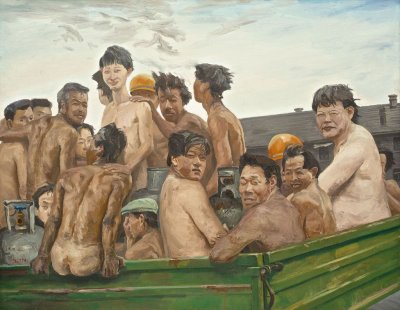Hong Kong Protests Panic Auction Houses on Eve of Sales
Auctioneers including Sotheby’s, Christie’s, Poly Auction, China Guardian, and Bonhams are gearing up to go head-to-head in Hong Kong next week in a series of high-estimate sales. Sotheby’s will kick off its season on October 4, taking over one floor of the Hong Kong Convention and Exhibition Centre (HKCEC).
However, the HKCEC was crowded this morning not by collectors and dealers, but by Hong Kong protesters and government officials. In celebration of China’s National Day on October 1, an official flag-raising ceremony took place at the Golden Bauhinia Square, which is adjacent to the HKCEC.
A group of student protesters attended the ceremony, turning their backs to the Chinese flag and raising their arms in crosses as a sign of protest. They, and other demonstrators, hope to achieve universal suffrage for Hong Kong, a Special Administrative Region under Chinese sovereignty that enjoys aspects of autonomous governance.
With tens of thousands of protesters swarming the streets of Hong Kong’s convention center and central business district just days ahead of the auction season, worries regarding the protests’ effect on the city’s art market have sprouted. However, insiders suggest that Hong Kong should be unaffected by the uprising at their gates.
In a statement to artnet News, a Sotheby’s spokesperson writes that “Despite some logistical challenges, we do not anticipate that the current situation will impact our exhibitions or sales, but, of course, we are closely monitoring events.”

Liu Xiaodong painting
Liu Xiaodong “Disobeying the Rules” (1996) will go under the hammer on October 5 at Sotheby’s Hong Kong, estimate upon request.
Alex Errera, founder of Artshare.com and advisor to collectors of Chinese contemporary art, concurs: “It’s not something that’s affecting the art market much. The official line from auction houses for now is that it’s business as usual.”
Since much of the bidding takes place over the phone or online, Errera is not worried that results on the high end will suffer, even if the auction grounds are physically blocked by Hong Kong protests. “Physical attendance is less important for key lots; you see more activity in the auction room for smaller lots,” he told artnet News.
While Western collectors generally sympathize with the cause of the Hong Kong protesters, Alex Errera does caution that buyers from mainland China may be undecided about the long-term future of the market as information about Hong Kong’s political situation is censored by the government. Instagram and foreign reports about the protests in Hong Kong have been blocked on the mainland.
The Hong Kong protests have been overwhelming the city for the past week. Many roads are empty of traffic as demonstrations block the main arteries of Hong Kong’s central business district in a movement dubbed Occupy Central. Pro-democracy protesters have stood their ground despite severe rainstorms and tear gas fired by Hong Kong police.
“Logistics might be a problem for some as there are no taxis or buses right now. The subway system is functioning but very crowded,” says Jean-Marc Decrop, a Hong Kong-based contemporary art specialist. He thinks the possibility of physical attendance at preview exhibitions might be more important for ceramics collectors: “They like to feel the piece, but most important collectors bid remotely anyway.”
Decrop, who opened Yallay Gallery in Hong Kong in 2013, is significantly more worried that gallerists will be affected in the long-term if traffic does not resume. “Auctions are sold piece by piece, but in galleries it is about the curated exhibition as a whole. Besides, we depend on overseas visitors as we cannot sustain ourselves on the local population of collectors alone,” he says.
For the moment, the primary market continues with business as usual. The Asia Contemporary Art Show issued a statement saying that the fair will take place without change on October 2–5 at the Conrad—located right in the middle of one of the major Hong Kong protest areas. They did not comment on how the protests might affect sales.
- Hair Salon Owner Found Beauty in $30 Million African Art
- Chinese Art Sales Tallied $8.5 Billion in 2013 on Rebound
- Giacometti Chariot Leads $500 Million Trophy Art at Sales
- Hong Kong Protests Panic Auction Houses on Eve of Sales
- Fallen Class-Action Lawyer Mel Weiss to Sell Picasso Works
- Collector Gets 422 Million AmEx Points With Cup Purchase
- Sydney Launches Interest-free Scheme to Buy Art






